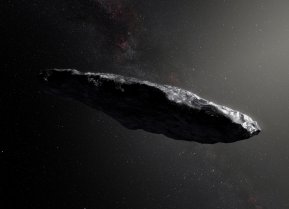Study: Interstellar object ‘Oumuamua' Could Be Made of Hydrogen Ice
Interstellar object ‘Oumuamua' first captured our attention when it whizzed through our solar system more than two years ago. Apparently, it’s still not done making headlines.
Interstellar object ‘Oumuamua first captured our attention when it whizzed through our solar system more than two years ago. Apparently, it’s still not done making headlines.
According to a new study, which has not yet been peer-reviewed, scientists are suggesting that the cigar-shaped ‘Oumuamua could be made of hydrogen ice. Although hydrogen is the most abundant element in the universe, it’s hardly ever observed in a solid form.
“We developed a theory that explains all of ‘Oumuamua’s weird properties,” the study’s co-author Gregory Laughlin, a professor of astronomy in Yale’s Faculty of Arts and Sciences, said in a statement.
“We show that it was likely composed of hydrogen ice. This is a new type of object, but it looks like there may be many more of them showing up, going forward.”
The study notes that hydrogen ice is often present in the cores of molecular clouds, which form the basis of stars. Researchers believe that ‘Oumuamua could contain hydrogen ice after it passed by one of these molecular clouds in deep space. This particular theory could also explain the object’s speed.
“As ‘Oumuamua passed close to the sun and received its warmth, melting hydrogen would have rapidly boiled off the icy surface,” Laughlin said, “providing the observed acceleration and also winnowing ‘Oumuamua down to its weird, elongated shape—much as a bar of soap becomes a thin sliver after many uses in the shower.”
It is possible that these iceberg-like objects made of hydrogen could be quite prevalent in our solar system, and studying them closely may offer researchers new data and information about how stars and planets initially form.
“Their presence would be an accurate probe of the conditions in the dark recesses of star-forming clouds and provide a critical new clue for understanding the earliest phases of the still-mysterious processes that generate the birth of stars and their accompanying planets,” Laughlin said.
‘Oumuamua, which means “a messenger that reaches out from the distant past” in Hawaiian, was first spotted by the Pan-STARRS project at the Haleakalā Observatory in Maui.
To keep its odd shape, ‘Oumuamua may have experienced extreme heating during flybys of its native star, and the eventual cooling caused it to develop a hard surface crust.
Ethen Kim Lieser is a Science and Tech Editor who has held posts at Google, The Korea Herald, Lincoln Journal Star, AsianWeek and Arirang TV. He currently resides in Minneapolis.


